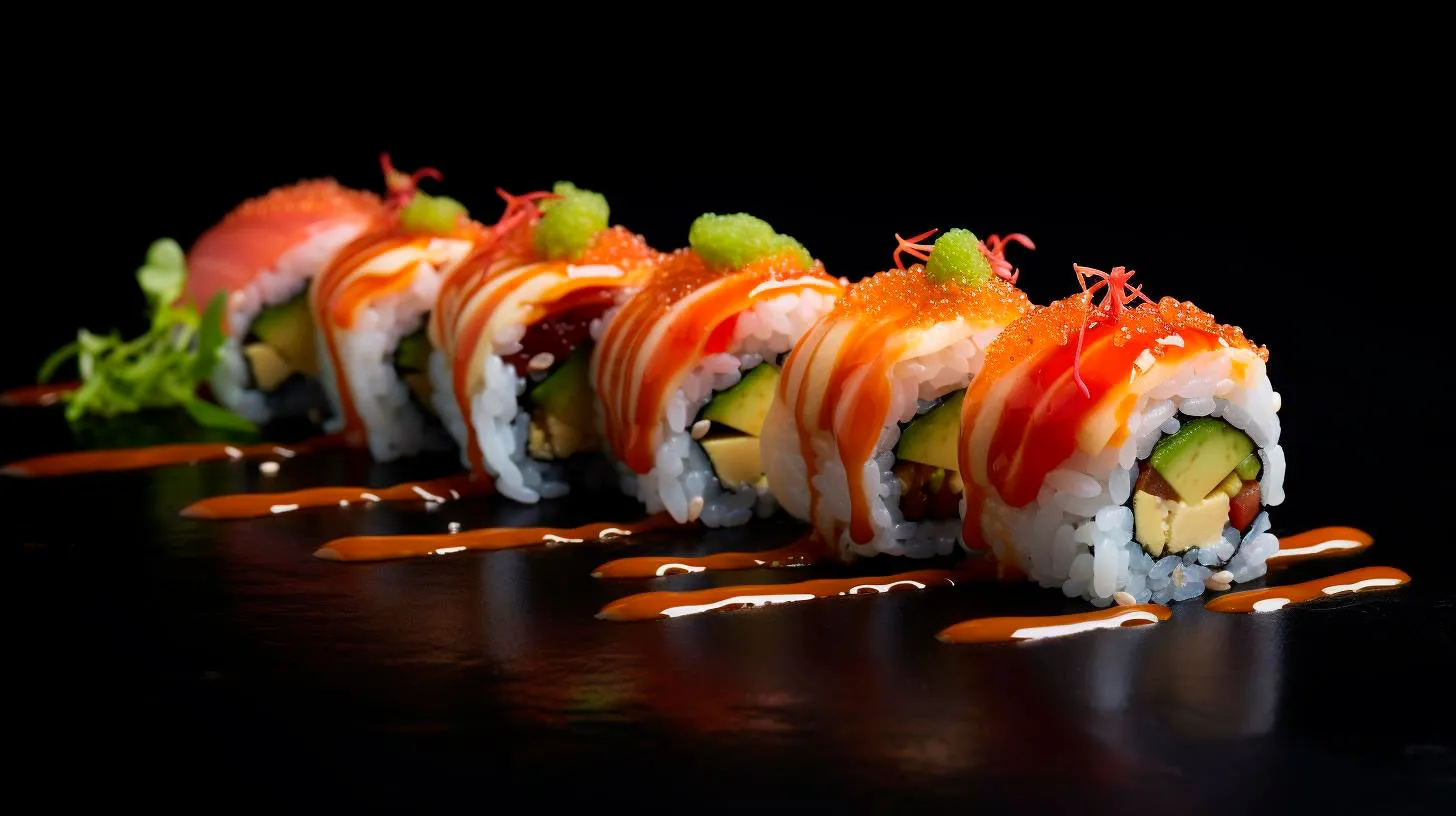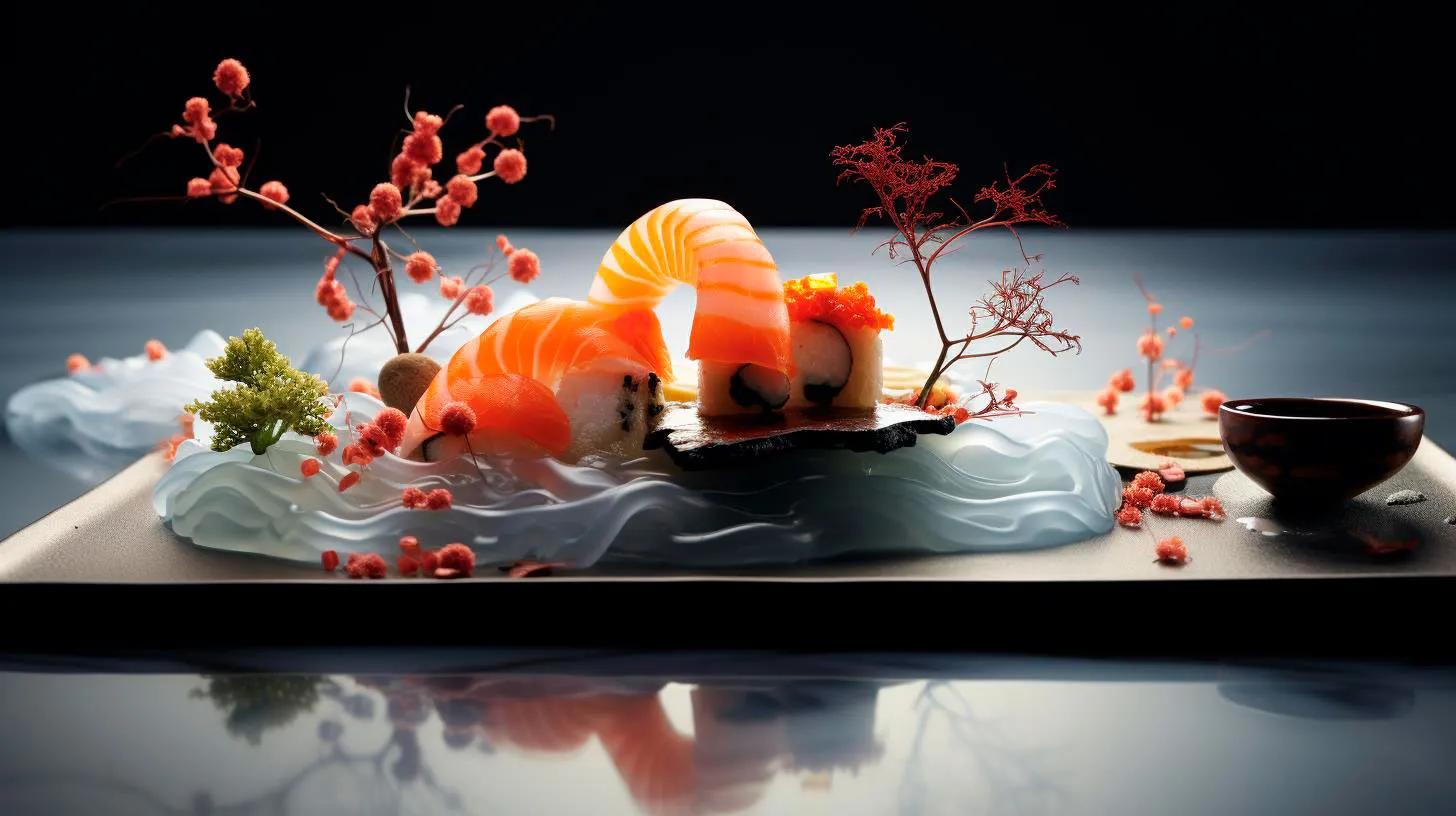How to Enjoy Sushi when Dealing with Food Allergies
In this article, we’ll explore how you can safely enjoy sushi while managing your food allergies.
Understanding Common Food Allergies
Before we dive into the world of sushi, let’s take a moment to discuss some common food allergies that can potentially impact your sushi experience:
- Shellfish Allergy: Shellfish, such as shrimp, crab, and lobster, is a common allergen that can cause severe allergic reactions.
- Fish Allergy: Some individuals may be allergic to one or more types of fish, which can include salmon, tuna, or mackerel.
- Soy Allergy: Soy sauce, a staple in sushi cuisine, contains soybeans, which can trigger allergic reactions.
- Gluten Allergy: Individuals with a gluten allergy or celiac disease need to be cautious of ingredients like soy sauce and imitation crab, as they often contain gluten.
While these are just a few examples, it’s important to know your specific allergies and understand which sushi ingredients are potential triggers for you.
The Art of Communicating Your Needs
When dining at a sushi restaurant, effective communication with the staff is crucial to ensure your safety. Here are some tips to help you navigate this process:
- Inform the server: Inform your waiter or waitress about your food allergies right from the beginning. Be specific and mention the exact ingredients you are allergic to.
- Ask about ingredients: Inquire about the ingredients in sushi dishes you are interested in and choose options that are safe for you. Be mindful of hidden ingredients in sauces or garnishes.
- Seek alternatives: If you’re allergic to commonly used sushi ingredients like soy sauce or shellfish, ask if there are suitable replacements available.
- Request minimal cross-contamination: Inform the server about the possibility of cross-contamination in the kitchen and request measures to minimize the risk.
By effectively communicating your needs and concerns, you can help the restaurant staff understand the severity of your allergies.
Choosing Allergy-Friendly Sushi Options
While many sushi rolls may contain allergens, there are still plenty of options for sushi lovers with food allergies. Here are some allergy-friendly sushi choices to consider:
- Vegetable Rolls: Opt for rolls filled with fresh vegetables like cucumber, avocado, or sweet potato for a delicious and allergen-free sushi experience.
- Tempura Rolls: Tempura rolls often consist of lightly battered and deep-fried vegetables. Just make sure to check the ingredients to avoid any potential allergens.
- Sashimi: Skip the rice and try sashimi, which consists of thinly sliced raw fish. Be cautious if you have a fish allergy and ensure the fish you choose is safe for consumption.
- Customizable Rolls: Some sushi restaurants offer customizable rolls where you can choose your own ingredients. This allows you to carefully select items that do not include your allergens.
Remember, always communicate your food allergies to the sushi chef or staff, as they can guide you towards safe options and assist with any inquiries you may have.
Bring Along Your Own Sauce
One common allergen found in many sushi dishes is soy sauce. However, you can still enjoy your sushi by bringing along your own allergy-friendly alternatives. Some options include gluten-free soy sauce, coconut aminos, or tamari sauce. Keeping these sauces on hand ensures that you can enjoy your sushi without compromising your health.
Final Thoughts
While having food allergies may complicate the dining experience, it should never prevent you from enjoying sushi. By understanding your allergies, communicating your needs effectively, and choosing allergy-friendly options, you can savor the flavors of sushi without worries. Remember to always put your health first and enjoy your sushi experience to the fullest.
Key Takeaways:
- Food allergies can pose challenges when dining out, but with proper precautions, enjoying sushi is still possible.
- Common allergens in sushi include shellfish, fish, soy sauce, and gluten, so be aware of your specific allergies.
- Inform the restaurant staff about your allergies and ask about ingredients and potential substitutes to ensure a safe dining experience.
- Choose allergy-friendly sushi options like vegetable rolls, tempura rolls, sashimi, or customizable rolls.
- Bring along your own allergy-friendly sauces, such as gluten-free soy sauce, coconut aminos, or tamari sauce.
Sushi 101: A Guide to Gluten-Free and Allergen-Friendly Options
In this guide, we will explore the world of gluten-free and allergen-friendly sushi, providing you with insights, tips, and delicious options to enjoy.
The Growing Demand for Gluten-Free and Allergen-Friendly Options
According to a study by Grand View Research, the global gluten-free food market is expected to reach a staggering $43.65 billion by 2027. This rise in demand is likely due to the increasing number of individuals seeking gluten-free and allergen-friendly options, including those who have celiac disease, gluten sensitivity, or specific food allergies.
Understanding Gluten and Common Allergens in Sushi
Gluten is a protein found in wheat, barley, and rye. It provides the elasticity in dough and is responsible for the chewiness in many grain-based products. Sushi typically includes ingredients like soy sauce, imitation crab meat, and tempura, all of which may contain gluten.
Aside from gluten, certain ingredients commonly found in sushi may cause allergic reactions. Here are some of the most common allergens lurking in sushi:
- Shellfish: Shrimp, crab, and other shellfish are popular sushi ingredients but can trigger allergic reactions in susceptible individuals.
- Seafood: Tuna, salmon, and other fish used in sushi may cause allergies, particularly in those with fish allergies.
- Soy: Soy sauce is commonly used in sushi preparations and may pose a problem for individuals with soy allergies.
- Vegetarian Allergens: Sushi can contain allergens like sesame seeds, avocado, or cucumber, which may cause reactions in some people.
- Others: Some individuals may have allergies to certain flavorings or additives used in sushi.
Navigating Gluten-Free Sushi
For those adhering to a gluten-free diet, enjoying sushi can still be a reality. By making informed choices and communicating your dietary needs to the sushi chef, you can savor a delectable gluten-free sushi experience. Here are essential tips:
- Choose Restaurants with Gluten-Free Options: Look for sushi restaurants that offer dedicated gluten-free menus or clearly label their allergy-friendly options.
- Opt for Sashimi: Sashimi is the perfect gluten-free alternative as it consists of thinly sliced raw fish without any soy sauce or gluten-containing ingredients. Just be cautious if the fish is marinated or flavored.
- Select Gluten-Free Sauces: Ask for gluten-free soy sauce, tamari, or ponzu sauce, which are free from gluten but still deliver exceptional flavors.
- Rice and Fillings: Ensure that the sushi rice does not contain any hidden sources of gluten. Stick to fillings like cucumber, avocado, fresh fish, or vegetables instead of tempura or imitation crab meat.
By following these tips and discussing your dietary requirements with the sushi chef, you can enjoy your sushi guilt-free and without compromising your gluten-free lifestyle.
Exploring Allergen-Friendly Sushi
When it comes to allergen-friendly sushi, communication is key. Many sushi chefs are accommodating and willing to customize your order to suit your specific allergen needs. Consider the following suggestions to enjoy allergen-friendly sushi:
- Inform the Staff: Let the staff know about your specific food allergies so they can guide you through the menu and recommend suitable options.
- Ask About Ingredient Labels: Inquire about the ingredients used in the sushi dishes, paying particular attention to potential allergens like shellfish, seafood, and soy.
- Customize Your Order: Request modifications to avoid allergens. For instance, ask for sushi rolls without sesame seeds if you have a sesame allergy or exclude certain ingredients from your order.
- Consider Vegan Sushi: Vegan sushi can be a great option for individuals with common allergens like shellfish, seafood, or soy. Vegetable rolls, avocado rolls, and cucumber rolls are often vegan-friendly and free from allergens.
Remember, it is crucial to communicate your allergies with the sushi chef and the restaurant staff to ensure a safe dining experience.
The Takeaway
Both gluten-free and allergen-friendly sushi options are becoming more widely available as the demand for these alternatives increases. By being knowledgeable about the ingredients, communicating your dietary needs effectively, and choosing the right sushi rolls, you can enjoy a delicious sushi experience without compromising your health or violating your dietary restrictions. Remember, sushi can be a delightful and safe choice for those with gluten intolerance or specific food allergies when navigated thoughtfully.
So why wait? Step into the enticing world of gluten-free and allergen-friendly sushi today and indulge in the flavors, textures, and creativity that sushi has to offer!
The Best Places to Find Gluten-Free and Allergen-Friendly Sushi
The Rise of Gluten-Free and Allergen-Friendly Options
With the growing awareness of gluten intolerance and food allergies, sushi restaurants have started to take note and offer options suitable for those with dietary restrictions. This not only allows a broader customer base to enjoy their delicious creations but also shows their commitment to providing inclusive dining experiences.
Key Takeaways:
- Sushi restaurants are increasingly offering gluten-free and allergen-friendly options.
- This caters to a broader customer base and shows a commitment to inclusivity.
- Gluten-free and allergen-friendly sushi is becoming more accessible worldwide.
Top Places to Find Gluten-Free and Allergen-Friendly Sushi
If you’re searching for the best places to find gluten-free and allergen-friendly sushi, look no further. Here are some renowned sushi restaurants that prioritize accommodating specific dietary requirements:
1. Sushi Maki
Sushi Maki is known for its attention to detail when it comes to dietary needs. They offer a separate gluten-free menu, ensuring that gluten-intolerant customers can enjoy their favorite sushi rolls without any worries. Their allergen-friendly options also extend to soy-free and nut-free choices, making it a popular choice for individuals with various dietary restrictions.
2. Blue C Sushi
Blue C Sushi is committed to providing safe and healthy dining experiences for everyone. They have a dedicated gluten-free menu that includes a wide range of sushi rolls, sashimi, and even gluten-free soy sauce. Their extensive customer reviews highlight their exceptional efforts to provide allergen-friendly options, making it a must-visit for those with dietary restrictions.
3. Beyond Sushi
As the name suggests, Beyond Sushi takes sushi to the next level by offering an entirely vegan and gluten-free menu. Their creative combinations of fresh produce and plant-based ingredients produce stunning sushi rolls that are not only visually appealing but also bursting with flavors. This restaurant has received rave reviews from vegans, vegetarians, and those with gluten intolerance or other allergies.
4. Fatty Fish
Fatty Fish is a sushi restaurant that goes above and beyond to meet the needs of its customers. They offer a gluten-free menu with an extensive selection of rolls, ensuring that gluten-intolerant individuals don’t miss out on the sushi experience. Additionally, they are also mindful of other common allergens, making it a safe choice for those with multiple dietary restrictions.
5. Sushi Ko
Sushi Ko is renowned for its dedication to providing gluten-free and allergen-friendly options without compromising on taste. They offer a separate gluten-free menu that includes a variety of rolls, nigiri, and sashimi. Additionally, their knowledgeable staff is well-versed in allergen information, ensuring a worry-free dining experience for their customers.
Key Takeaways:
- Sushi Maki, Blue C Sushi, Beyond Sushi, Fatty Fish, and Sushi Ko are top sushi restaurants for gluten-free and allergen-friendly options.
- These restaurants have dedicated gluten-free menus and accommodate various dietary restrictions.
- Vegan and vegetarian options are also available at Beyond Sushi.
Why Gluten-Free and Allergen-Friendly Options Matter
Providing gluten-free and allergen-friendly options in sushi restaurants is vital for several reasons:
- Accessibility: By offering these options, sushi restaurants make their dishes accessible to a wider range of customers, creating a more inclusive dining experience.
- Health and Safety: For individuals with gluten intolerance or allergies, consuming food that contains these substances can have severe health consequences. Having allergen-friendly options ensures their safety and well-being.
- Customer Satisfaction: Meeting the dietary needs of customers shows that the restaurant genuinely cares about their well-being and satisfaction. This can significantly enhance the overall dining experience and foster customer loyalty.
In conclusion, sushi lovers who have gluten intolerance or certain food allergies can still indulge in their favorite cuisine without any worries. Sushi restaurants like Sushi Maki, Blue C Sushi, Beyond Sushi, Fatty Fish, and Sushi Ko prioritize providing gluten-free and allergen-friendly options, ensuring that everyone can enjoy a delicious and safe dining experience. With the rise of these accommodating establishments, gluten-free and allergen-friendly sushi is becoming more accessible worldwide.
Exploring the Delicious World of Gluten-Free Sushi
In this article, we will delve into the world of gluten-free sushi, its benefits, and key takeaways.
The Key Advantages of Gluten-Free Sushi
Gluten-free sushi offers several advantages that make it an appealing choice for individuals with dietary restrictions. Here are some key features and benefits of gluten-free sushi:
- Alternative Ingredients: Traditional sushi rolls are typically made with vinegared rice and seaweed. To make gluten-free sushi, alternative ingredients are used to replace the ones containing gluten. For instance, gluten-free soy sauce or tamari is used as a substitute for regular soy sauce.
- Expanded Menu Selection: Gluten-free sushi offers a wider and more diverse menu selection, catering to a broader array of dietary preferences. This includes options such as sushi rolls made with brown rice or even quinoa, providing a nutritious and flavorful alternative.
- Health Benefits: Choosing gluten-free sushi can have numerous health benefits. Many gluten-free ingredients used in sushi, such as quinoa, are rich in essential nutrients, fiber, and antioxidants. Additionally, these alternatives often have lower calorie and carbohydrate content, making it a healthier choice for calorie-conscious individuals.
Key Takeaways when Trying Gluten-Free Sushi
If you are considering trying gluten-free sushi, keep these key takeaways in mind:
- Communication: When ordering sushi at a restaurant, it is essential to communicate your dietary restrictions clearly. Inform the staff about your gluten sensitivity or celiac disease so that they can guide you towards suitable options.
- Preparation: Cross-contamination can be a concern in kitchens that handle gluten-containing ingredients. To ensure your gluten-free sushi remains free from cross-contamination, look for restaurants that have separate preparation areas or are certified gluten-free.
- Reading Labels: If you choose to buy pre-packaged gluten-free sushi from stores, always read labels carefully to guarantee it is truly gluten-free. Look for certifications indicating the product is gluten-free to ensure your safety.
Indulge in Gluten-Free Sushi!
Gluten-free sushi is a delightful option for sushi enthusiasts with dietary restrictions. Whether you are gluten-intolerant or prefer a healthier alternative, there is a plethora of choices available. Savor the unique flavors and textures while experiencing the following benefits:
- Enjoy a wider menu selection with alternatives like brown rice and quinoa sushi rolls.
- Benefit from the essential nutrients, fiber, and antioxidants offered by gluten-free ingredients.
- Lower your calorie and carbohydrate intake while satisfying your sushi cravings.
- Discover restaurants with separate preparation areas or that are certified gluten-free for safer dining experiences.
- Read labels carefully to ensure the sushi you purchase is truly gluten-free.
Remember, gluten-free sushi allows you to explore and relish the world of sushi without compromising your dietary needs. Embrace this culinary delight and open the doors to a whole new world of flavors, textures, and healthy options!


